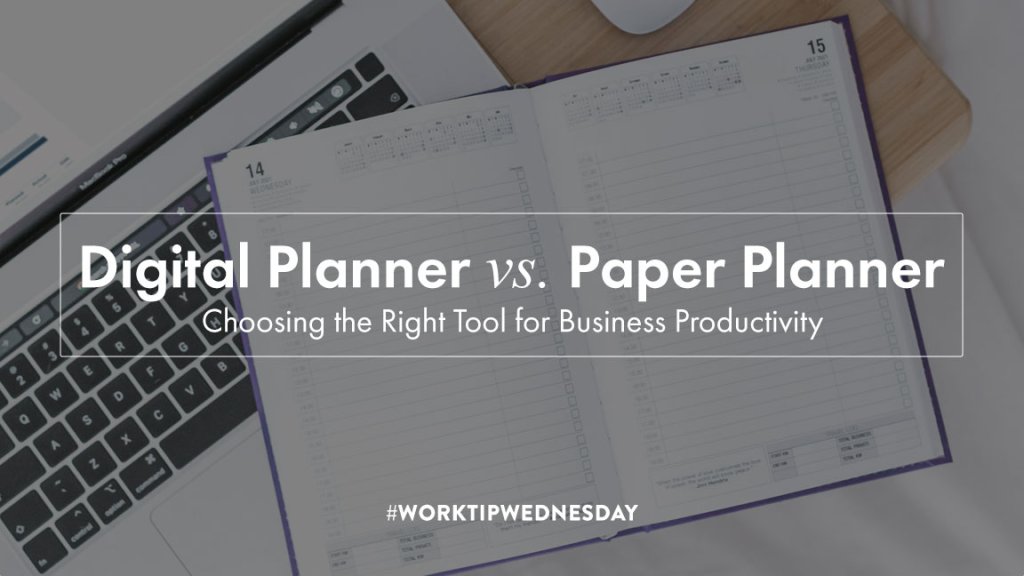
In the fast-paced world of modern business, staying organized is paramount to success. One of the dilemmas professionals face is choosing between digital planners and traditional paper planners to manage their weekly schedules and tasks. Each option has pros and cons, making the decision a matter of personal preference and specific needs. Let’s delve into the advantages and disadvantages of digital and paper planners to help you make an informed choice to maximize your business productivity.
Digital Planner:
Pros:
- Accessibility: Digital planners can be accessed from various devices such as smartphones, tablets, and computers, ensuring your schedule is always at your fingertips, whether in the office, on the go, or working remotely.
- Flexibility: Digital planners often offer features like cloud synchronization and automatic updates, allowing seamless integration across multiple platforms and enabling real-time collaboration with colleagues or clients.
- Customization: Many digital planner apps provide customizable layouts, templates, and color-coding options, allowing users to tailor their planners to suit their preferences and organizational styles.
- Search and Filter Functions: Digital planners usually come equipped with search and filter functions, enabling quick retrieval of specific information or tasks, saving time, and enhancing efficiency.
- Integration with Other Tools: Digital planners often integrate with other productivity tools such as email clients, task managers, and project management software, streamlining workflows and centralizing all relevant information in one place.
Cons:
- Dependence on Technology: Digital planners rely on electronic devices and internet connectivity, making them susceptible to technical glitches, software malfunctions, and potential data loss or security breaches.
- Learning Curve: Transitioning to a digital planner may require a learning curve for some users, especially those less comfortable with technology or accustomed to traditional paper-based methods.
- Distractions: The devices used for digital planning can also serve as sources of distraction, tempting users to veer off task with notifications, emails, or social media alerts.
- Battery Dependency: Unlike paper planners, digital planners rely on battery power, meaning users must ensure their devices are adequately charged or risk losing access to their schedules at crucial moments.
- Subscription Costs: While some digital planner apps offer free versions, premium features, and advanced functionalities often come with subscription fees, adding to the overall cost of ownership.
Paper Planner:
Pros:
- Tactile Experience: For many users, the tactile experience of writing tasks and appointments by hand can enhance memory retention and cognitive processing, leading to improved organization and productivity.
- Minimal Distractions: Paper planners eliminate the distractions inherent in digital devices, providing a focused environment conducive to deep work and concentration.
- No Technical Issues: Paper planners don’t rely on technology, so users don’t have to worry about software updates, compatibility issues, or data loss due to electronic malfunctions.
- Personalization: Paper planners offer a high level of personalization through decorative elements, handwriting styles, and the ability to add physical attachments like sticky notes or business cards.
- Improved Time Management: Some users find that physically flipping through pages and manually writing down tasks helps them develop better time management skills and a deeper understanding of their priorities.
Cons:
- Limited Accessibility: Paper planners are confined to the physical realm, meaning users may not have access to their schedules when they are away from their planner or when carrying a physical planner is inconvenient.
- Space Limitations: Paper planners have finite space, making it challenging to accommodate extensive schedules or frequent changes without cluttering pages or needing to carry additional notebooks.
- Risk of Loss or Damage: Paper planners are vulnerable to loss, damage from spills, or wear and tear over time, potentially leading to the loss of valuable information and disruptions to workflow.
- Lack of Integration: Paper planners operate independently of digital tools, requiring manual input for tasks that could otherwise be automated or synchronized across multiple platforms.
- Inflexibility: Once written, entries in a paper planner are static and difficult to modify, requiring crossing out or erasing tasks in the event of changes, which can lead to clutter and confusion.
Whether you opt for a digital planner or a paper planner for managing your weekly business productivity, each has its merits and drawbacks. Digital planners offer unparalleled accessibility, customization, and integration with other tools but come with the risk of technical issues and potential distractions. On the other hand, paper planners provide a tangible, distraction-free experience conducive to improved focus and time management but lack the flexibility and convenience of their digital counterparts.
Ultimately, the choice between a digital planner and a paper planner boils down to personal preferences, work habits, and the specific demands of your professional life. Some individuals may find a hybrid approach, combining digital and paper planning elements, to be the most effective solution. Whichever option you choose, the key is to select a planning tool that aligns with your workflow and helps you stay organized and productive in achieving your business goals.
